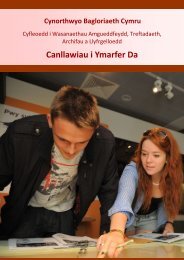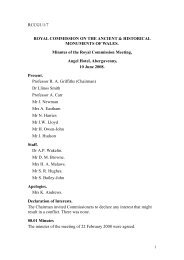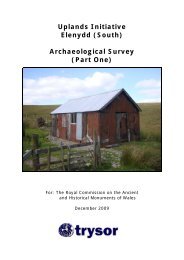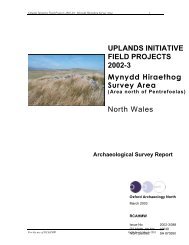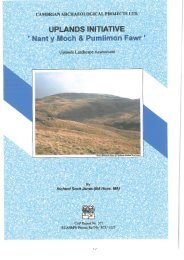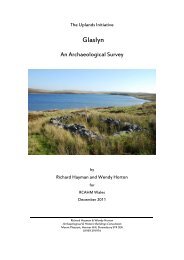Foel Goch Archaeological Survey - Royal Commission on the ...
Foel Goch Archaeological Survey - Royal Commission on the ...
Foel Goch Archaeological Survey - Royal Commission on the ...
Create successful ePaper yourself
Turn your PDF publications into a flip-book with our unique Google optimized e-Paper software.
Uplands Initiative Field Projects 2011-12: <str<strong>on</strong>g>Foel</str<strong>on</strong>g> <str<strong>on</strong>g>Goch</str<strong>on</strong>g> <str<strong>on</strong>g>Survey</str<strong>on</strong>g> Report 12<br />
style settlement and agriculture in <strong>the</strong> regi<strong>on</strong>. These encroachments were to c<strong>on</strong>tinue<br />
down <strong>the</strong> centuries by a process of neglect (by <strong>the</strong> Crown), corrupti<strong>on</strong> and stealth<br />
(op cit, 31). Large tracts of <strong>the</strong> upland moorland presumably remained ostensibly<br />
Crown Lands in <strong>the</strong> post-medieval period; however, <strong>the</strong> farms and cultivable lands<br />
surrounding <strong>the</strong>se areas, toge<strong>the</strong>r with certain encroachments <strong>on</strong> to <strong>the</strong> comm<strong>on</strong>s,<br />
were increasingly amalgamated into large estates through crown leases. There was a<br />
fur<strong>the</strong>r phase of enclosure, added after <strong>the</strong> ti<strong>the</strong> schedule, which reflects <strong>the</strong> largescale<br />
acquisiti<strong>on</strong> of Crown Lands by means of <strong>the</strong> Enclosure Acts of <strong>the</strong> mid-1860s.<br />
The Enclosure Acts c<strong>on</strong>solidated holdings of comm<strong>on</strong> grazing into enclosed<br />
sheepwalks. The majority of <strong>the</strong> study area was open comm<strong>on</strong> land in 1847<br />
(Thomas 1967, 232) and, apart from land around Moel Emoel, remained comm<strong>on</strong><br />
after <strong>the</strong> Enclosure, unlike, for example, land to <strong>the</strong> west around Llyn Celyn which<br />
all came under <strong>the</strong> ownership of <strong>the</strong> Rhiwlas estate (OA North 2009). The lowland<br />
distributi<strong>on</strong> of land ownership in <strong>the</strong> valley below <strong>the</strong> study area was <strong>on</strong>e of<br />
c<strong>on</strong>solidated landholdings to <strong>the</strong> south-west associated with <strong>the</strong> Rhiwlas estate and<br />
individual private freeholders with comm<strong>on</strong> grazing rights running up Cwm Main to<br />
<strong>the</strong> south and east. The private landholdings were increasingly amalgamated in <strong>the</strong><br />
late-nineteenth/twentieth century by both intermarriage and aband<strong>on</strong>ment of small<br />
unprofitable farmsteads. The hamlet of Pentre-tai-yn-y-cwm within <strong>the</strong> isolated cwm<br />
in <strong>the</strong> centre/south of <strong>the</strong> study area was reduced from over 90 individuals to just<br />
<strong>on</strong>e family in this period (Mr E M Owen pers com).<br />
3.3.8 By <strong>the</strong> nineteenth century <strong>the</strong> Rhiwlas estate had reached its maximum extent<br />
through prudent land acquisiti<strong>on</strong>s and intermarriage; by <strong>the</strong> time of <strong>the</strong> ti<strong>the</strong><br />
schedules in <strong>the</strong> 1840s it was <strong>the</strong> third largest estate in Meri<strong>on</strong>eth with 14,751 acres<br />
(Thomas 1967, 232-233 [Fig 4] and 238). By <strong>the</strong> end of <strong>the</strong> century it owned almost<br />
16,500 acres (GAT 2006, 1), and <strong>the</strong> estate actively extended <strong>the</strong> area of<br />
cultivatable lands into <strong>the</strong> uplands with improvements of <strong>the</strong> existing ffridd<br />
enclosures through drainage and st<strong>on</strong>e clearance. The study area mostly lay outside<br />
of <strong>the</strong> large-scale land acquisiti<strong>on</strong>s undertaken by <strong>the</strong> estate in <strong>the</strong> period of <strong>the</strong><br />
Enclosure Acts in <strong>the</strong> 1860s but <strong>the</strong>ir landholding in <strong>the</strong> study area encompassed<br />
land to <strong>the</strong> south-west edge of <strong>the</strong> area. This c<strong>on</strong>tained Moel Emoel which was<br />
recorded as waste <strong>on</strong> a schedule of land, dated 1863, immediately prior to <strong>the</strong> estate<br />
buying it from <strong>the</strong> Crown (Z/DDD/1/191). Surrounding land at <strong>the</strong> farmstead of<br />
Eglwys-Anne was presumably already owned by <strong>the</strong> estate pre-1860s and this was<br />
where <strong>the</strong> Warren Ffridd was located. The land of <strong>the</strong> study area was predominantly<br />
held as upland sheepwalks for stock grazing and to a lesser extent as shooting<br />
moorland for <strong>the</strong> estate <strong>on</strong> <strong>the</strong> south-west end.<br />
3.3.9 The Rhiwlas Estate had first developed shooting lands nearer to <strong>the</strong> estate seat with<br />
a mixture of rabbit warrens, pheasant coverts and grouse shooting. The study area<br />
did not c<strong>on</strong>tain <strong>on</strong>e of <strong>the</strong> main grouse shooting moors, such as that at Arenig Fach<br />
(OA North 2009) but did c<strong>on</strong>tain 350 acres of land at Eglwys-Anne which was<br />
designated as <strong>on</strong>e of <strong>the</strong> three rabbit warrens (with attached pheasant covert)<br />
recorded <strong>on</strong> an undated (?late nineteenth century) schedule in <strong>the</strong> Rhiwlas archive<br />
(Z/DDD/1/200). This block of land was leased out <strong>on</strong> <strong>the</strong> schedule for a yearly rent<br />
of £200 to Herbert J Parkes esq. Ano<strong>the</strong>r warren was located just south of <strong>the</strong> study<br />
area at College Warren and a fur<strong>the</strong>r <strong>on</strong>e to <strong>the</strong> west at Fr<strong>on</strong> <str<strong>on</strong>g>Goch</str<strong>on</strong>g> where numerous<br />
pillow mounds still survive. To give an example of <strong>the</strong> industrial scale of <strong>the</strong><br />
For <strong>the</strong> use of RCAHMW © OA North: February 2012




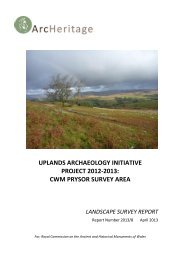
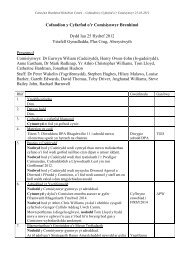
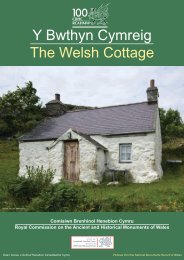

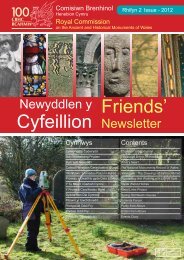
![The Source of the Usk Walk [2012 PDF]](https://img.yumpu.com/49285699/1/190x245/the-source-of-the-usk-walk-2012-pdf.jpg?quality=85)

